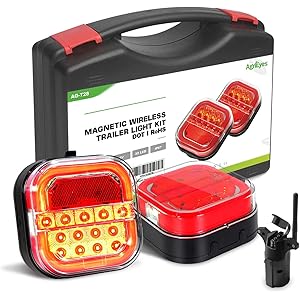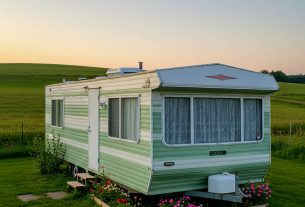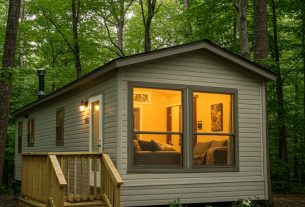Have you ever found yourself driving through a neighborhood and spotted a home that piqued your interest, only to wonder if it’s a manufactured home? You’re not alone! Many people are curious about distinguishing between manufactured homes and traditional site-built homes. In this article, I’ll share key signs to help you identify manufactured homes, along with insights that might surprise you. Let’s dive in!
Understanding Manufactured Homes
Before we get into the nitty-gritty of identification, it’s essential to understand what manufactured homes are. These homes are built in a factory and transported to a site, where they are installed on a foundation. This contrasts with site-built homes, which are constructed entirely on the chosen plot of land. According to the U.S. Census Bureau, nearly 20 million Americans live in manufactured homes, so understanding them is crucial!
The Importance of Recognizing Manufactured Homes
Knowing how to identify manufactured homes is not just for curiosity’s sake. There are practical implications, including:
- Real estate transactions: Understanding the differences can affect property value.
- Insurance: Different types of homes may require different insurance policies.
- Zoning laws: Some areas have specific regulations regarding manufactured homes.
- Financing: Manufactured homes may have different financing options compared to traditional homes.
Key Signs that Indicate a Home is Manufactured
Now that we’ve laid the groundwork, let’s explore the key signs that can help you identify whether a home is manufactured.
1. Look for the HUD Tag
One of the most telling signs of a manufactured home is the HUD tag. This tag, often located on the exterior of the home, indicates that it meets the standards set by the U.S. Department of Housing and Urban Development (HUD). Each tag has a unique identification number and serves as a testament to the home’s construction quality.
2. Check for a Serial Number
Manufactured homes typically have a serial number that can be found inside the home, often on a label located near the main electrical panel, or in the kitchen cabinet. This number is essential for registration and helps potential buyers verify the home’s history.
3. Examine the Construction Quality
When I walk through a home, I pay special attention to construction quality. Manufactured homes often have a different build quality compared to traditional homes. For instance:
- Walls may be thinner.
- Windows may be smaller and less energy-efficient.
- Flooring might feel different, often using materials like vinyl or laminate.
4. Look for a Single-Section Design
Many manufactured homes come in a single-section design. This means they are often more compact and can be transported in one piece. While double-wide homes do exist, they still retain a unique layout that differs from traditional homes.
5. Foundation Type
Manufactured homes can be found on various foundation types, but most commonly, they are placed on piers or blocks rather than a full basement. If you see a home elevated off the ground on blocks, it’s likely a manufactured home.
6. Notice the Roof Design
Many manufactured homes feature a simpler roof design. While traditional homes often have complex roof structures, manufactured homes tend to have a more straightforward gable or flat roof. This is a direct result of their factory-built nature.
7. Check the Exterior Materials
The materials used on the exterior can also be a giveaway. Manufactured homes often have aluminum or vinyl siding, while traditional homes typically utilize brick, stucco, or wood. If the exterior looks more like a mobile home than a conventional house, it might be a manufactured home.
Statistics and Case Studies
To further solidify my points, let’s look at some statistics. According to the Manufactured Housing Institute (MHI), the average cost of a manufactured home is about 10-30% less than that of a site-built home. This affordability makes them an attractive option for many families.
In a case study conducted in Florida, a community of manufactured homes showed that residents saved, on average, $200 monthly in housing costs compared to traditional homeowners in the same region. This significant savings can make a huge difference in a family’s financial health.
The Benefits of Living in a Manufactured Home
Aside from identifying manufactured homes, I feel it’s also essential to discuss the benefits of living in one. Here are some of the key advantages:
- Affordability: As mentioned, manufactured homes are generally less expensive than traditional homes.
- Quick Construction: These homes can be built and moved to your desired location much faster than a traditional build.
- Energy Efficiency: Many modern manufactured homes are designed with energy-efficient features that reduce utility costs.
- Variety of Styles: Today’s manufactured homes come in various styles and sizes, making it easy to find one that suits your taste.
Common Myths About Manufactured Homes
Despite the advantages, misconceptions abound. Let’s debunk some of the most common myths surrounding manufactured homes.
Myth 1: They Are Poor Quality
Many people assume that manufactured homes are of inferior quality. However, with modern building standards and regulations, many manufactured homes are built to last and offer excellent quality.
Myth 2: They Depreciate Quickly
While it’s true that some manufactured homes can depreciate, many retain their value effectively, especially if they are well-maintained and located in desirable communities.
Myth 3: They Are Only for Low-Income Families
This myth is outdated. Today, manufactured homes attract a diverse range of homeowners, including retirees and young professionals seeking affordable housing options.
Join the Conversation! Your Thoughts Matter
As I’ve shared, identifying manufactured homes can be quite insightful. But what do you think? Have you lived in a manufactured home, or do you know someone who has? I invite you to join the conversation! Share your experiences or ask questions in the comments below.
Frequently Asked Questions (FAQ)
What is the difference between a manufactured home and a mobile home?
A mobile home is a term used for homes built before July 15, 1976, when HUD standards were introduced. After this date, the term “manufactured home” became standard, reflecting updated regulations and construction quality.
Are manufactured homes safe during extreme weather?
Modern manufactured homes are built to withstand various weather conditions. Many come equipped with features that enhance their durability against storms and extreme temperatures.
Do manufactured homes appreciate in value?
Yes, many manufactured homes can appreciate, particularly when placed in desirable areas and maintained well. Location and community play significant roles in a home’s value.
Conclusion: Embrace the Knowledge
In closing, I hope this article has equipped you with the knowledge to identify manufactured homes and appreciate their benefits. Understanding the key signs can empower you in various aspects, from real estate transactions to making informed living choices. If you found this article helpful, consider signing up for our newsletter for more insights and tips. Don’t forget to share this with friends and on social media to spread the word!
Agrieyes Halo Wireless Trailer Lights, 2 Mounting Options Magnetic Trailer Light for Towing, Portable LED Tow Lights Kit for Trucks, Boat, RV
$79.99 (as of November 16, 2025 07:53 GMT -03:00 - More infoProduct prices and availability are accurate as of the date/time indicated and are subject to change. Any price and availability information displayed on [relevant Amazon Site(s), as applicable] at the time of purchase will apply to the purchase of this product.)
Sign up for our newsletter and stay up to date with exclusive news
that can transform your routine!





